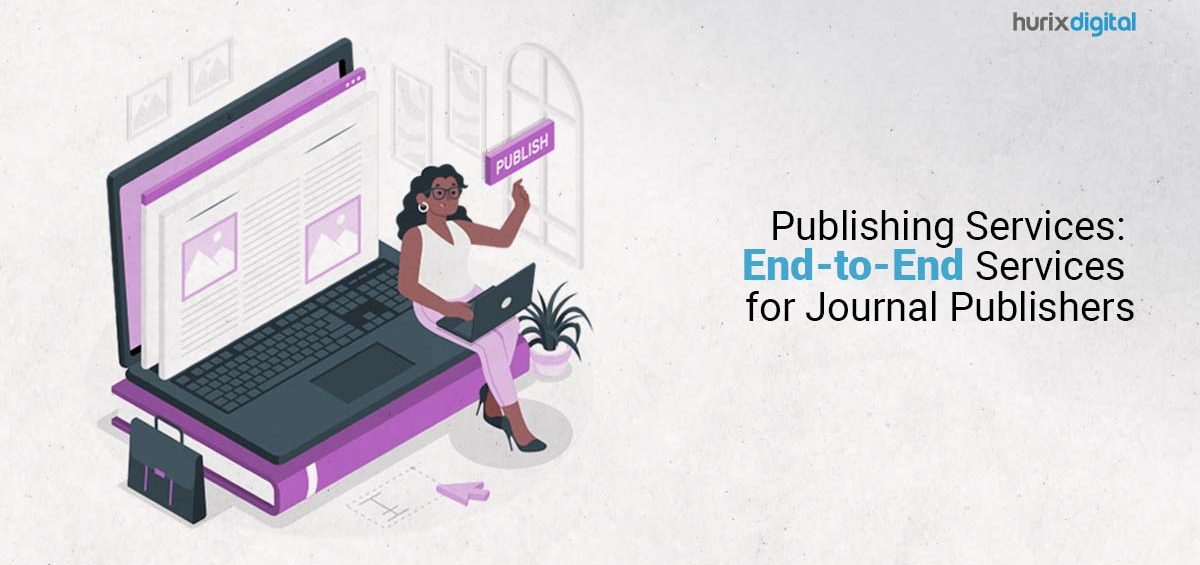Summary
The blog post showcases end-to-end publishing services for journal publishers. It outlines the comprehensive support offered, including editorial services, typesetting, XML conversion, artwork creation, and multi-channel distribution.
End-to-end services for a journal publisher typically include a range of activities related to the publication process, from manuscript submission to final publication.
Table of Contents:
- Six Key Services That a Publisher Can Offer
1. Manuscript Submission
2. Copyediting and Proofreading
3. Typesetting and Layout
4. Production and Printing
5. Online Publishing and Hosting
6. Marketing and Promotion
Six Key Services that a publisher might offer include
- Manuscript submission and management: This involves providing authors with a platform to submit their manuscripts, and managing the review process, including coordinating peer review, managing author revisions, and communicating with authors and reviewers throughout the process.
- Copy editing and proofreading: This involves reviewing manuscripts for errors in grammar, punctuation, and syntax, and ensuring that they are formatted according to the publisher’s style guidelines.
- Typesetting and layout: This involves formatting the manuscript for publication, including designing the layout, selecting fonts, and arranging images and tables.
- Production and printing: This involves coordinating the printing and distribution of the journal, including overseeing the printing process, managing inventory, and ensuring timely delivery to subscribers.
- Online publishing and hosting: This involves providing an online platform for the journal, including hosting the journal’s website, managing subscriptions, and providing access to articles and other content.
- Marketing and promotion: This involves promoting the journal to potential authors, subscribers, and readers, through advertising, social media, and other marketing channels.
Overall, the goal of end-to-end services for a journal publisher is to ensure that the publication process runs smoothly and that the journal is produced and distributed in a timely and efficient manner while maintaining high standards of quality and professionalism.
Manuscript Submission
Manuscript submission is the process by which authors submit their work to a publisher or a journal for consideration for publication. Here are some of the key steps involved in manuscript submission:
- Research and select a suitable publisher or journal for submission. This may involve checking the scope of the journal and its previous publications to ensure that the manuscript is a good fit.
- Prepare the manuscript according to the publisher’s or journal’s guidelines. This may involve formatting the manuscript, including figures and tables, and ensuring that it meets the required word count and style.
- Submit the manuscript through the publisher or journal’s online submission system. This may involve creating an account and uploading the manuscript, along with any supplementary material such as cover letters, author information, or data files.
- Wait for the editor’s response. The editor will typically send an acknowledgment of receipt and may also provide an estimated time frame for the review process.
- Respond to any queries or requests for revisions from the editor or peer reviewers. This may involve revising the manuscript, providing additional information or data, or addressing any concerns raised during the review process.
- Receive a final decision from the editor. This may be acceptance, rejection, or a request for further revisions.
- If the manuscript is accepted, sign a publishing agreement and prepare the final version of the manuscript for publication.
The manuscript submission process can vary depending on the publisher or journal, so it is important to carefully read and follow the submission guidelines provided by the publisher or journal.
Copyediting and Proofreading
Copyediting and proofreading are essential steps in the publishing process that help ensure that a manuscript is clear, correct, and consistent in its presentation. Here are some of the key steps involved in copyediting and proofreading:
- Copyediting: This is the process of reviewing a manuscript to correct errors in spelling, grammar, punctuation, and syntax, as well as to ensure consistency in style and formatting. This may also involve checking for factual accuracy and suggesting revisions to improve the overall clarity and coherence of the text.
- Proofreading: This is the final stage of editing, which involves reviewing the manuscript after it has been typeset or formatted for publication. The goal of proofreading is to catch any remaining errors in spelling, grammar, or formatting that may have been missed during copyediting.
- Tools: Copyediting and proofreading can be done manually or with the help of various software tools. Some popular tools for copyediting and proofreading include Grammarly, Hemingway Editor, and ProWritingAid.
- Professional Services: Publishers may also choose to outsource copyediting and proofreading to professional editors who specialize in the field. Professional editors may work freelance or as part of a publishing services company, and they may offer a range of editing services, including developmental editing, line editing, copyediting, and proofreading.
The copyediting and proofreading process can vary depending on the specific requirements of the manuscript and the publisher’s standards. However, both processes are essential for ensuring that a manuscript is clear, correct, and consistent in its presentation.
Typesetting and layout
Typesetting and layout are important steps in the publishing process that involve formatting a manuscript for publication. Here are some of the key steps involved in typesetting and layout:
- Preparing the manuscript: Before typesetting and layout can begin, the manuscript must be finalized and edited. This may involve working with the author to make any necessary revisions, checking for accuracy and consistency, and ensuring that all necessary components (such as figures, tables, and references) are included.
- Choosing a software tool: There are many different software tools available for typesetting and layout, including Adobe InDesign, LaTeX, and Microsoft Publisher. The choice of tool will depend on the publisher’s preferences, as well as the complexity of the manuscript.
- Setting up the template: Once a software tool has been selected, a template must be created for the manuscript. This template will dictate the overall layout and design of the manuscript, including the font, margins, headers, footers, and any special formatting.
- Formatting the text: The text of the manuscript must be formatted according to the template, including adjusting line spacing, paragraph indents, and hyphenation.
- Adding images and figures: If the manuscript includes images or figures, these must be placed in the layout and formatted according to the template. This may involve resizing, cropping, or adjusting the resolution of the images.
- Finalizing the layout: Once all of the elements of the manuscript have been added to the layout, the final version must be reviewed and approved by the publisher. This may involve making minor adjustments to the layout or formatting based on feedback from the publisher.
Typesetting and layout can be complex and time-consuming processes, but they are essential for ensuring that a manuscript is visually appealing and easy to read. By carefully formatting the text and images of a manuscript, publishers can create a professional and polished final product that is both informative and engaging.
Production and printing
Production and printing are the final steps in the publishing process, where the manuscript is prepared for distribution in its final printed form. Here are some of the key steps involved in production and printing:
- Prepress: Before printing can begin, the manuscript must be prepared for printing. This may involve making final adjustments to the layout, formatting, and images, as well as preparing the manuscript for printing.
- Printing method: There are many different printing methods available, including digital printing and offset printing. The choice of printing method will depend on factors such as the print run, the type of publication, and the desired print quality.
- Printing setup: Once the printing method has been selected, the printing press must be set up for the print run. This may involve adjusting ink levels, calibrating the printing plates, and preparing the paper stock.
- Printing: Once the press is set up, the printing can begin. This may involve multiple passes through the press for different colors or finishes, depending on the desired final product.
- Finishing: Once the printing is complete, the final product must be finished. This may involve binding the pages, trimming the edges, and adding any special finishes such as embossing or foil stamping.
- Quality control: Throughout the printing process, quality control measures are taken to ensure that the final product meets the publisher’s standards for quality and accuracy. This may involve spot-checking pages for errors, measuring color accuracy, or checking for defects in the finished product.
- Distribution: Once the final product has been approved and finished, it can be distributed to booksellers, wholesalers, or directly to customers.
The production and printing process can be complex and time-consuming, but it is essential for ensuring that the final product is of high quality and meets the publisher’s standards. By carefully managing the printing process, publishers can create a final product that is visually appealing, informative, and engaging.
Online publishing and hosting
Online publishing and hosting refer to the process of creating and publishing content on the internet and making it available to the public through a website or other online platforms.
Online publishing involves the creation and distribution of digital content, such as articles, blog posts, e-books, videos, podcasts, and other forms of media, through the internet. This content can be created by individuals, businesses, or organizations and can be accessed by anyone with an internet connection.
Online hosting, on the other hand, involves the storage and management of digital content on servers or other online platforms. This content can include websites, applications, databases, and other digital assets. Online hosting providers offer various services to help individuals and businesses manage their digital content, including web hosting, cloud hosting, and content management systems.
Together, online publishing and hosting enable individuals and organizations to share their ideas, products, and services with a global audience, creating new opportunities for communication, collaboration, and commerce in the digital age.
Marketing and promotion
Marketing and promotion are two essential components of a successful business strategy.
Marketing refers to the overall process of creating, communicating, delivering, and exchanging offerings that have value for customers, clients, partners, and society at large. It involves identifying and understanding customer needs and preferences, developing products and services that meet those needs, and creating messages and experiences that communicate the value of those offerings to target audiences.
Promotion, on the other hand, refers specifically to the tactics and tools used to communicate the value of products and services to target audiences. This can include advertising, public relations, personal selling, sales promotions, direct marketing, and digital marketing. Promotion is an essential part of the marketing mix and is designed to create awareness, generate interest, stimulate demand, and ultimately drive sales.
Together, marketing and promotion work to create and sustain customer relationships, build brand awareness and loyalty, and drive business growth and profitability. An effective marketing and promotion strategy requires a deep understanding of customer needs and preferences, a clear value proposition, and a comprehensive plan for reaching and engaging target audiences through multiple channels and touchpoints.
Also Read: What are Prepress Editorial Services?







